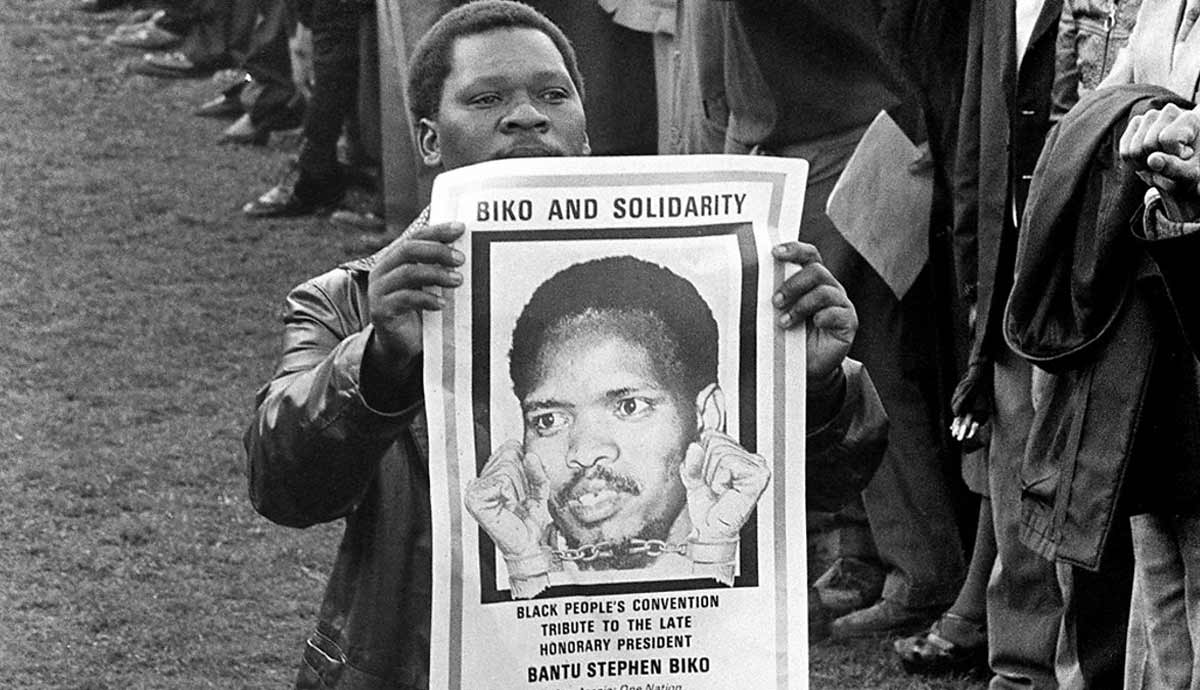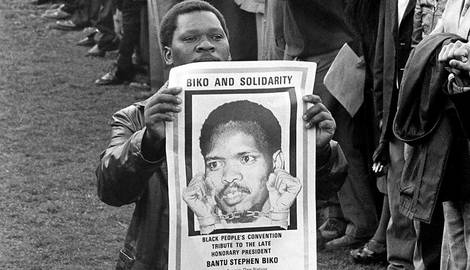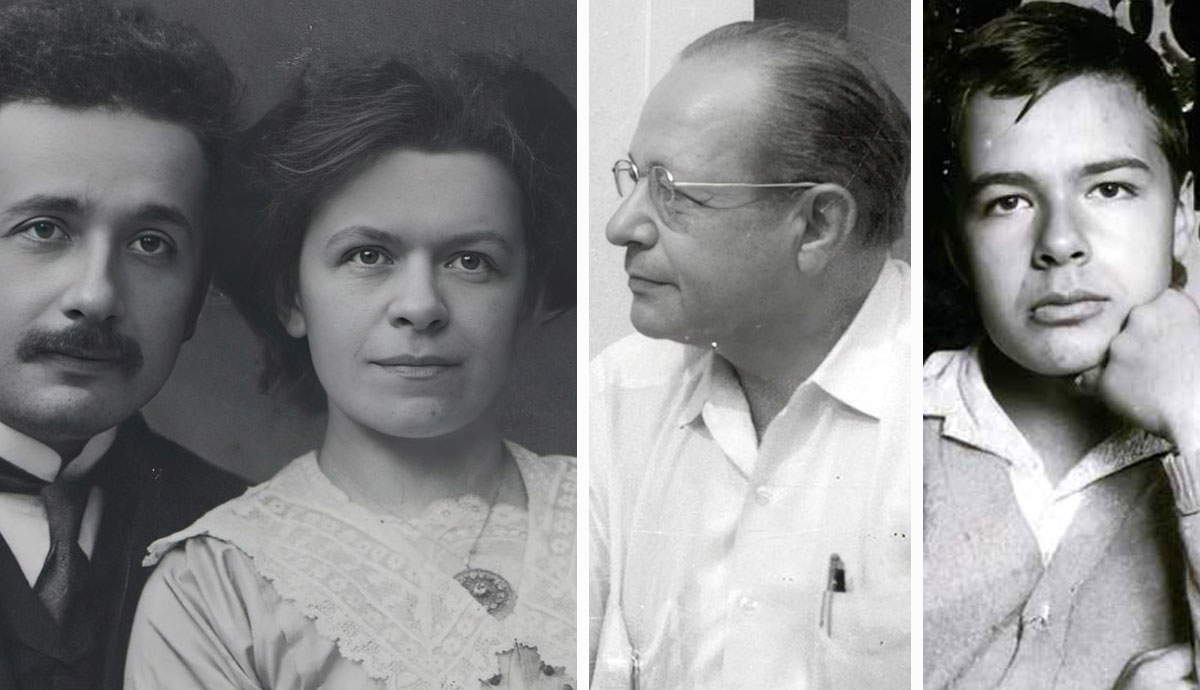
As colonialism in South Africa transformed into the brutality of apartheid, the role of black people in South African society was pushed to a position of absolute contempt. Black people worked the most menial jobs. They worked in the mines and on the farms. Many cleaned the houses of white people and worked in their gardens. Others were infantilized to the point where white people referred to black adults as “boy” or “girl.” Not only was their dignity stripped by the society in which they lived, but in their own minds, they were instilled with a sense of no self-worth. Anger at their predicament often turned to self-pity as they grew tired of fighting against such a powerful adversary.
In the 1960s, after the jailing of many African National Congress and Pan-Africanist Congress members, as well as the banning of these two organizations themselves, resistance took a new route. The Black Consciousness Movement sprung up and moved to instill in non-white people a sense of political consciousness and a restoration of their human dignity.
Ideology of the Black Consciousness Movement

For many black people, the early apartheid years were a time of frustration regarding feeling represented on any meaningful level. The African National Congress and Pan-Africanist Congress, movements that represented the hopes of black people, were banned and had difficulty making themselves present in South African society. Although the armed wing of the ANC, uMkhonto we Sizwe (founded by Nelson Mandela), was active, it was a small guerilla army that couldn’t occupy South African land and did not have diplomatic power to win concessions from the apartheid government. In the perceived vacuum of black leadership, various organizations sprang up to address various issues relevant to the struggle for liberation and human rights for black South Africans.
The theoretical underpinning of the Black Consciousness Movement was one of re-shaping the dignity of black people by focusing on the fact that they were black. In this context, the term “black” was used to describe all non-white people. The existence of black culture and history were championed as sources of pride that formed a foundation for black people not feeling as if they had to be judged by white norms and standards. Through these circumstances, black people were offered the chance to be psychologically liberated, even under conditions where this freedom was suppressed.
Many of these ideas were spread via the words of activist Stephen Biko. He became a symbol of the struggle for liberation, especially after his death at the hands of apartheid police in 1977. His ideas were influenced from many sources, such as WEB Du Bois, Marcus Garvey, Aimé Césaire, Frantz Fanon, and Léopold Senghor. The Black Consciousness Movement also drew much influence from political ideologies such as Marxism, Leninism, Pan-Africanism, African Socialism, and even included black theology, which became integral as it provided an alternative for spiritual expression.
The Early Years of the Black Consciousness Movement

The BCM was kickstarted by black students who wanted distinct black power separate from the supposedly “non-racial” student groups in which white students were the majority. They fought for an identity that unified all oppressed people in South Africa. The movement spread rapidly as black people found a new sense of pride. Many took part in leadership seminars, and Black Community Programs were established and served as avenues for self-sufficiency in black communities. Through the BCP, buildings were constructed all over the country to serve the needs of black people and the BCM. Many journals were also published and disseminated within black communities, including Black Voice, Black Review, Black Perspective, and Creativity in Development.

The BCP also organized mass protests and strikes, severely impacting the country in the early 1970s. In 1973, the government began to respond forcefully to these movements and banned them under the pretext that these movements were treasonous to black development. Widespread arrests were made, including the leadership of the BCP and the South African Students Organization (SASO). The following year, many top members of the BCM were arrested after holding a protest in support of the socialist FRELIMO government in neighboring Mozambique (there was a civil war between FRELIMO and the capitalist RENAMO. The apartheid government supported the latter). These leaders used the arrests as an opportunity to explain their ideology. Instead of the movement being crushed, it grew even further in popularity.
From 1976 Onwards

The BCM was deeply involved in the protests which shook the country in 1976. Thousands of students took to the streets to protest the new laws, which demanded that black people be taught in Afrikaans. These protests led to a riot on June 16, where South African police opened fire with live ammunition, leading to the deaths of 176 people (some estimates put the toll at over 700).
In the wake of the protests, the government tried to quell the growing unrest. This led to the arrest of Steve Biko. On September 12, 1977, Biko was beaten to death while in custody. A month after his death, the government declared 19 organizations linked to the BCM to be illegal. This further motivated black people to resist, and a new generation of activists swelled the ranks of the ANC and joined more established organizations such as the ANC, even though they were banned. Meetings were held to discuss new ways to resist, and out of these meetings, the Azanian People’s Organization was created: a political party that, along with the ANC and the PAC, still exists in South Africa’s political sphere. The movement also was helped in the form of one of South Africa’s most prominent voices, that of Nobel Peace Prize recipient Archbishop Desmond Tutu, who garnered support from all over the world.

The success of the BCM was also the reason for its decline. It instilled in many a sense of resistance and encouraged the growth of resistance nationwide. Many BCM members formed their own organizations, which evolved away from the tenets of the BCM movement. Nevertheless, the BCM had clearly been a success, as the black population had found a renewed sense of self-worth and the will to resist the injustices pressed upon them.
Meanwhile, the ANC came back to prominence as its plight was recognized internationally, and its support allowed it to be a presence within the lives of black South Africans who swelled its ranks.
The Legacy of the Black Consciousness Movement

While the heyday of the BCM is certainly over, it is because it is no longer needed on such a large scale. In that, it is clear that the BCM accomplished what it set out to do. The Black Consciousness Movement exists as an ideology and a theoretical viewpoint from which to conduct other activities. After the fall of apartheid, it was no longer necessary to conduct resistance movements, but nevertheless, the tenets of black consciousness are prominent in South African politics today. Chief among them is the restoration and preservation of dignity. Although technically aimed across the racial divide, it is clear that the theory is enacted where it is most needed.
Despite its success, however, the BCM was not without criticism. Donald Woods, a white liberal and close friend of Steve Biko, remarked on “the unavoidably racist aspects of Black Consciousness.” Its focus on “blackness” did not attract widespread appeal from other non-white groups. While it received much support from many who came to power after the fall of apartheid (and many who subsequently reside in government today), the emphasis of a movement solely for non-white people is very much downplayed by many South African politicians including Nelson Mandela. This attitude shows that the focus on “blackness” is at odds with the ANC government’s ideal of multi-racialism. In this, critics argue that the BCM’s ideas are obsolete and act as a hindrance to the ideals of New South Africa.

Other critics argue that the movement was ineffective in roles other than providing a theoretical framework for other organizations. They also argue that the community programs enacted by the BCM were too small to make significant differences. In addition, it has been pointed out that the BCM failed to bridge tribal divides among black South Africans–divides that still exist today.
Nevertheless, the BCM is still celebrated today as a significant part of the struggle for freedom. For many black people, the theories are just as important today as they were when they were founded.










